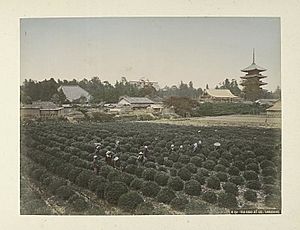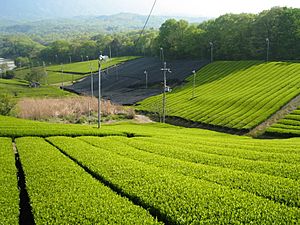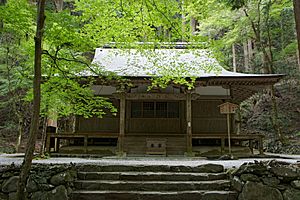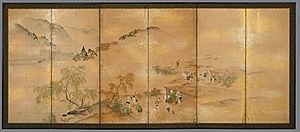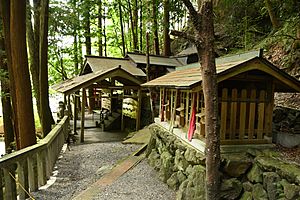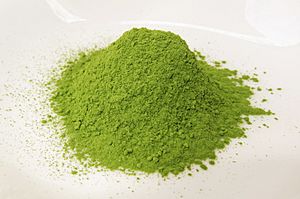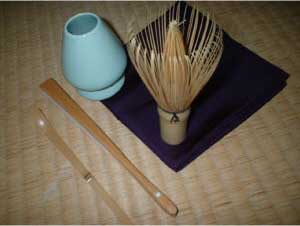Uji tea facts for kids
Uji tea (宇治茶 (Uji-cha)) is a special type of Japanese green tea. It comes from the Uji area in Kyoto, Japan. The three main kinds of Uji tea are Matcha, Sencha, and Gyokuro. Japanese tea first came from China during the Tang Dynasty. This was a time when Japan was very influenced by Chinese culture. When tea seeds arrived in Japan, they were first planted in a place called Toganoo. Later, these seeds were also planted in Uji. Uji soon became famous for growing the best tea leaves in Japan.
Uji has seen many changes in how green tea is made. At first, high-quality matcha was only for rich people. But in the 1700s, Sencha was created for everyone to enjoy. Later, Gyokuro was made by combining methods from both matcha and sencha. Uji tea became very popular because of special tea ceremonies. These include Tōcha, Chanoyu, and Senchadō.
Contents
History of Uji Tea
First Tea Records
Around 804 AD, a Japanese Buddhist monk named Kukai Hoken Hyu visited China. He stayed there for two years. When he returned, he brought back books and art. He also started teaching Buddhist ideas in Japan. Kukai wanted to show his discoveries to Emperor Saga. It is written that Emperor Saga was drinking "chanoyu" while reading the books. Since "chanoyu" means hot tea, this is the first time tea drinking was recorded in Japan.
The Best Uji Tea
People debate if tea grew naturally in Japan or if it came from other countries. Records show that tea leaves and seeds arrived at different times. Tea seeds were brought to Japan around 1191. A Zen priest named Myoan Eisai brought them. These seeds were first planted in Toganoo. This place was known for producing "honcha," which means "real tea." Around 1350, Toganoo tea was thought to be the best tea in the country.
Eisai also shared tea seeds with his friend, Myoe Shonin. Myoe Shonin started a tea farm in Uji. By 1383, Uji tea was ranked as the second-best tea. However, this ranking was questioned in 1460. A shogun named Ashikaga Yoshimasa asked why Uji tea was so popular now. He wondered if Toganoo tea was still the best. With Yoshimasa's support, Uji tea soon became as highly regarded as Toganoo tea.
After this, Uji tea was traded and given as gifts more often. By the late 1500s, Uji tea took over from Toganoo as the main producer of "honcha." Three things helped this happen. First, the tea farm in Toganoo was run by a monk from Kōzanji temple. This monk lent the tea fields to another cleric without writing it down. After the monk died, there was a big fight over who owned the tea fields. This caused problems for growing and selling tea there.
Second, Uji tea kept getting more popular in Japan. This happened even with the issues in Toganoo. The growth of tea ceremonies helped a lot. These ceremonies saw tea drinking as a form of art. Important tea masters like Murata Jukō, Takeno Jōō, and Sen no Rikyū helped create this unique tea culture. Because of this, the demand for powdered green tea from Uji grew.
Third, tea farmers in Uji created a new way to grow tea. It was called the "roof-over method" or ōishita saibai. This method used grass, straw, or reeds to build a roof over the tea plants. This blocked sunlight from reaching the plants. It slowed down photosynthesis, which made the tea sweeter. The ōishita saibai method also protected the plants from insects and bad weather like mist and frost.
Tea Farming in Uji
Uji is known for producing very high-quality tea leaves. This is because of several things. The soil is good, the climate is often misty, and there are sloping hills. Also, the Obuku area in Uji almost never gets frost, even in winter. Tea from Uji is often given to the Imperial Family. It is also used in important tea ceremonies. Many local farmers still use old, traditional ways to process tea leaves. They do not rely on machines. This knowledge is passed down through families. This helps them keep making high-quality tea.
Tea Cultivation and Processing
The Uji Method
In the 1500s, a shading method called Ōishita Saibai was invented in Uji. This method led to the creation of Tencha and Matcha. Making high-quality matcha powder made Uji tea even more famous. Records from 1413 to 1567 show that Uji tea was very valuable. It cost 500 coins per kilogram, while a cup of tea was only 5-6 coins.
However, there were strict rules about using the shading method. This meant Tencha and Matcha were only for the rich. Ordinary people could only get lower-grade green tea like bancha.
Soen Nagatani was a tea farmer from Ujitawara. He wanted to make high-quality tea without needing the shading method. After 15 years of trying, he invented Sencha in 1738. It quickly became popular across Japan. Sencha is made using the Uji Method (Aoseisenchahou). This is also known as the Uji-cha Tea Hand Knead Tea Production Technique.
The Uji Method has 10 main steps:
- Steaming the tea leaves.
- Cutting the tea.
- Yokomakuri (rolling the tea leaves).
- Tamatoki (breaking up clumps of tea leaves).
- Nakaage (cooling the tea leaves).
- Chazoroe (rubbing and rolling leaves into long, twisted shapes).
- Denguri (shaping tea leaves into round shapes).
- Itazuri (kneading tea leaves into thin, round shapes).
- Drying the tea.
- Finishe (kneading tea leaves into thin and long shapes).
Soen Nagatani shared his knowledge with other tea farmers. His house and things are now a museum. A temple called Chasomyo Shrine (茶宗明神社) was built for him. His invention, the Uji Method, became the main way to process tea in Japan.
Spread of Tea Production
Other villages wanted to learn the successful Uji tea methods. In places like Shimosa and Hitachi, farmers used an old method of sun-drying tea leaves. This method made good tea, but only small amounts each year. This put farmers at a disadvantage. They could not compete with bigger tea markets. This was especially true as farming became more commercial in the mid-1700s.
To help local tea markets, Shichirobei from Nagatsura village invited expert tea farmers from Uji. They helped improve how much tea was produced. Other villages followed this example. These included Nakayama Monotari of Heta village and Nomura Saheiji of Yamazaki village. The growing tea industry made tea a major export for Japan by 1859. By 1867, tea trading was 18 times bigger than in 1859. About 7 million pounds of tea were exported that year. Tea farming in Japan also grew by 66% in just 10 years by 1883. Many areas in Yamashiro, Kyoto, were cleared to grow tea. This included Wazuka Town and Minami Yamashiro Village.
Main Types of Uji Tea
Matcha
Matcha is a very well-known type of Japanese tea. It is a high-grade tea. The first matcha powder was made in Uji in the 1500s. It used the Ōishita Saibai method. Matcha is famous for its use in the tea ceremony, Chanoyu, by Sen no Rikyu. Matcha that is darker in color often has a stronger, slightly bitter taste.
Matcha plants are grown using a special shading method called Ōishita Saibai. To make matcha, the leaf veins and thin stems must be removed. This allows the powdered matcha to dissolve completely in water.
Sencha
Sencha is a middle-grade tea. It is the most popular tea in Japan. It makes up more than 80% of all tea produced. It is made using the Uji Method. Tea leaves for Sencha are picked from areas that get direct sunlight. After picking, they are steamed and rolled. Sencha has a unique sweet taste with a little bit of bitterness.
Sencha has many vitamins. It is a popular drink for women during teatime.
Gyokuro
Gyokuro is a high-grade tea. It was invented in the 1800s. It combines the Ōishita Saibai method and the Uji method. The tea leaves are harvested from a shaded area, like matcha. Then, they are steamed and rolled, like sencha.
Gyokuro has a lot of chlorophyll. This makes it a dark green color after it dries. The high levels of caffeine and chlorophyll can help stimulate brain activity and tissue growth.
Tea Ceremonies
Uji tea is a big part of Japanese daily life. The tea-drinking culture in Uji helped create and develop many tea ceremonies. A proper tea ceremony needs a special room called a chasitsu (tearoom). It also needs a teishu (experienced tea master).
Uji has a long history of tea culture. Many teahouses there offer tea ceremony experiences. Some of these include Taihoan, Nakamura Tokichi Honten, and Fukujuen Ujicha Kobo.
Tocha (Tea Contest)
As tea became more popular, Japanese people created a tea tasting contest. It was called tocha. This contest helped tell the difference between "honcha" (real tea) and "hicha" (non-tea). This happened during the Nanboku-chō period. When tocha first started, Toganoo tea was "honcha." Tea from other places was "hicha." But Uji tea quickly became popular and replaced Toganoo tea as "honcha."
Tocha spread to other parts of Japan as the prizes grew. It was later called "tea affairs of excess or extravagance." Because of this, tocha was banned in Japan. It slowly disappeared.
Chanoyu
In the 1500s, a Zen Buddhist monk named Sen no Rikyu created Chanoyu. He was also known as the Tea Master. He combined tea culture with rituals. He connected it to religious and philosophical ideas. Chanoyu is more than just drinking tea. It combines tea, art, and beauty. It expresses "wabi," which means simple beauty. It is seen as a spiritual event. Matcha is used, and it stands for purity.
The discovery of the Ōishita Saibai method in the 1500s helped Chanoyu grow. The matcha made this way had a strong flavor and a dark green color. Sen no Rikyu used the best tea leaves from Japan in Chanoyu. This helped make Chanoyu very successful.
An important part of chanoyu is the proper way to drink matcha. It is believed that drinking matcha with good posture, with a straight back, makes the experience better. When serving matcha, the teishu places the teacup on their left palm. They then turn the cup to face the guest. The guest takes the teacup and places it on their left palm. They hold the cup with their right hand too. The teacup must be turned clockwise again. This avoids drinking from the front of the teacup. The guest then finishes the cup of matcha in exactly three and a half sips.
Senchadō
Senchadō was developed by a Chinese monk named Ingen Ryūki in the 1600s. Senchadō means "the way of sencha." It describes how to prepare loose tea leaves like sencha and gyokuro.
The word "sencha" first meant simmering loose tea leaves in boiling water. This method was common in China. But it was less common in Japan because powdered tea was so popular. Senchadō only became popular in the 1700s. This was when Baisaō, Ingen's student, spread Senchadō around Japan. Also in the 1700s, Soen Nagatani invented Sencha. The word "Sencha" then changed. It went from describing how to prepare loose tea leaves to being a type of green tea that is steamed and dried.
Becoming a UNESCO World Heritage Site
Uji tea has a 700-year history in the Yamashiro area of Kyoto. It is where the Ōishita Saibai method and the Uji method were created. These methods are used on flat land and sloping hills. This area also has tea factories that process "aracha" tea. There are also tea wholesalers and "Gogumi," which collects tea leaves from different areas at different times. According to Kyoto Prefecture, these are important parts of Uji tea culture. They have changed and grown over the last 700 years.
This growth can be seen with the creation of new teas. These include matcha, sencha, and gyokuro. These green teas support Japanese tea-drinking cultures. Examples are chanoyu and senchadō. Because of this, the Kyoto Prefecture is working to make the Uji landscape a UNESCO World Heritage Site.


